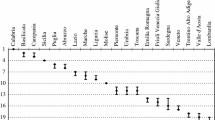Abstract
State is often involved in the challenging process of judicious allocation and apportioning of resources for an inclusive growth through creating infrastructure and ensuring accessibility- the “ability of the people to reach and engage in opportunities and activities”. The issue at the heart of the debate concerns with the “opportunities” available in a geographic area and the inhabitants’ use of those opportunities in terms of their “behaviour”. The extant literature suggests that the dominant component of the accessibility is mobility infrastructure. The present paper argues that the impact of the human development and the information infrastructure should also be considered. This paper uses the Indian census data of 2001 and develops the methodology for creating an accessibility index for a geographic unit. The paper also discusses the use of the accessibility index (AI) as a tool for evaluating the efficacy of a public policy initiative towards decreasing the exclusion of geographic units. Validation of the tool is done using the patient inflow data at a large charitable hospital in Central India and household level employment data from National Rural Employment Guarantee Scheme (NREGS).
Similar content being viewed by others
Notes
The National Rural Employment Guarantee Scheme (NREGS) is an initiative by the Government of India to provide employment to the households in rural areas. Under this scheme the Government provides at least 100 days of employment in every financial year to every adult in a household. The nature of employment provided is voluntary unskilled manual work.
The National Rural Employment Guarantee Scheme (NREGS) is an initiative by the Government of India to provide employment to the households in rural areas. Under this scheme the Government provides at least 100 days of employment in every financial year to every adult in a household. The nature of employment provided is voluntary unskilled manual work.
References
Aday, L. A., & Andersen, R. (1974). A framework for the study of access to medical care. Health Services Research, 9, 208–220.
Coombes, M., Raybould, S., Wong, C., & Openshaw, S. (1995). Towards an index of deprivation: a review of alternative approaches. In Department of Environment (Eds.), 1991 Deprivation Index: a review of approaches and a matrix of results. London: HMSO.
Farrington, J., & Farrington, C. (2005). Rural accessibility, social inclusion and social justice: Towards conceptualization. Journal of Transport Geography, 13(1), 1–12.
Field, K., & Briggs, D. J. (2001). Socio-economic and locational determinants of accessibility and utilisation of primary health care. Health and Social Care in the Community, 9(5), 294–308.
Filmer, D., & Pritchett, L. H. (2001). Estimating wealth effects without expenditure data-or tears: An application to educational enrollments in states of India. Demography, 38(1), 115–132.
Gulliford, M., Figueroa-Munoz, J., Morgan, M., Hughes, D., Gibson, B., Beech, R., et al. (2002). What does ‘access to health care’ mean? Journal of Health Services Research and Policy, 7(3), 186–188.
Hay, A. M. (1995). Concepts of equity, fairness and justice in geographical studies. Transactions of the institute of British geographers. New Series, 20(4), 500–508.
Higgs, G. (2004). A literature review of the use of GIS-based measures of access to health care services. Health Services and Outcome Research Methodology, 5, 125–145.
Higgs, G., & White, S. (2000). Alternative Indicators of social disadvantage in rural communities: The example of rural wales. Progress in Planning, 53(1), 1–81.
Hofstede, G. H. (2001). Culture’s consequences: Comparing values, behaviors, institutions and organizations across nations. Thousand Oaks, California: Sage Publications.
Martin, J. C., & Reggiani, A. (2007). Recent methodological methods to measure spatial interaction: Synthetic accessibility indices applied to high-speed train investments. Transport reviews, 27(5), 551–571.
McIntyre, D., Muirhead, D., & Gilson, L. (2002). Geographic patterns of deprivation in South Africa: Informing health equity analyses and public resource allocation strategies. Health Policy and Planning, 17(Suppl 1), 30–39.
McKenzie, D. (2005). Measuring inequality with asset indicators. Journal of Population Economics, 18(2), 229–260.
Mor, N. (2005). Expanding access to financial services: Where do we go from here? Economic & Political Weekly, 40(12), 1122–1127.
Moseley, M. (1979). Accessibility: The rural challenge. London: Methuen & Co. Ltd.
Penchansky, R., & Thomas, J. W. (1981). The concept of access. Medical Care, 19, 127–140.
Pirie, G. (1981). The possibility and potential of public policy on accessibility. Transportation Research, 15A(5), 377–381.
Preston, J. M., & Raje, F. (2007). Accessibility, mobility and transport-related social exclusion. Journal of Transport Geography, 15(3), 151–160.
Sen, A. (2000). Social exclusion: concept, application and scrutiny. Social development papers No 1. Manila: Office of environment and social development, Asian Development Bank. Available from <http://www.Xacso.org/biblioteca/sen_social_exclusion.pdf>5). (accessed on 06 Feb, 2009).
Sen, A. (2001). Development as freedom. New Delhi: Oxford University Press.
Sharma, S. (1995). Applied multivariate techniques. NY, USA: Wiley.
Shucksmith, M., Roberts, D., Scott, D., Chapman, P., & Conway, E. (1996). Disadvantage in rural areas. Research report 29. London: Rural Development Commission.
Taylor, M., Sekhar, S., & D’Este, G. (2000). Application of accessibility based methods for vulnerability analysis of strategic road networks. Networks and Spatial Economics, 6(3–4), 267–291.
Virginia, P. (2004). Accessing work: The effects of spatial and social accessibility on unemployment for native-born black and immigrant women in Los Angeles. Economic Geography, 80(2), 141–172.
Vyas, S., & Kumaranayake, L. (2006). Constructing socio-economic status indices: How to use principal components analysis. Health Policy Plan, 21(6), 459–468.
Walford, N. S. (1986). Indicators of inequality as pointers to policy: A census perspective. In P. Lowe, A. J. Bradley, & S. Wright (Eds.), GeoBooks. Norwich: Rural Deprivation and Welfare.
White, A. N. (1979). Accessibility and public facility location. Economic Geography, 55(1), 18–35.
Acknowledgments
We would like to acknowledge the support of management and staff at Sadguru Netra Chikitsalaya (SNC), Chitrakoot, India for their support in data collection.
Author information
Authors and Affiliations
Corresponding author
Rights and permissions
About this article
Cite this article
Bisht, S.S., Mishra, V. & Fuloria, S. Measuring Accessibility for Inclusive Development: A Census Based Index. Soc Indic Res 98, 167–181 (2010). https://doi.org/10.1007/s11205-009-9537-3
Accepted:
Published:
Issue Date:
DOI: https://doi.org/10.1007/s11205-009-9537-3




